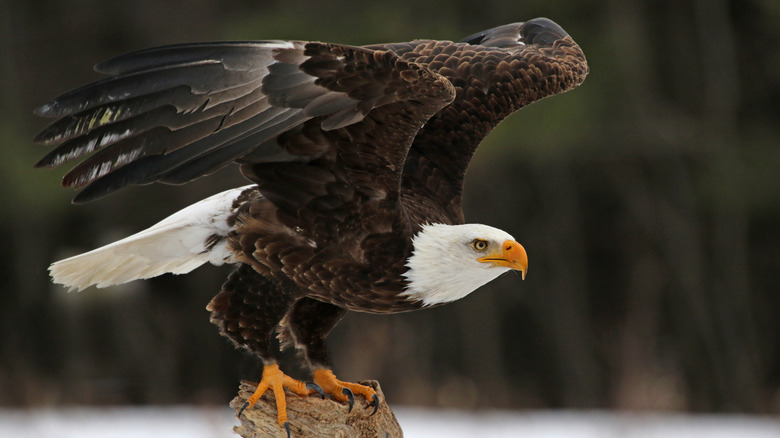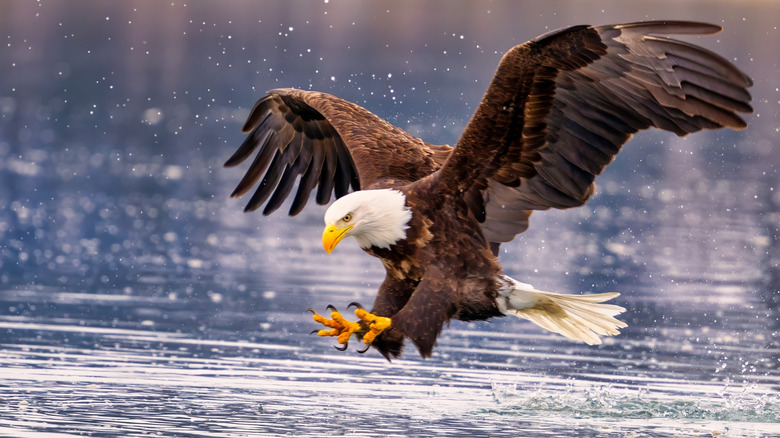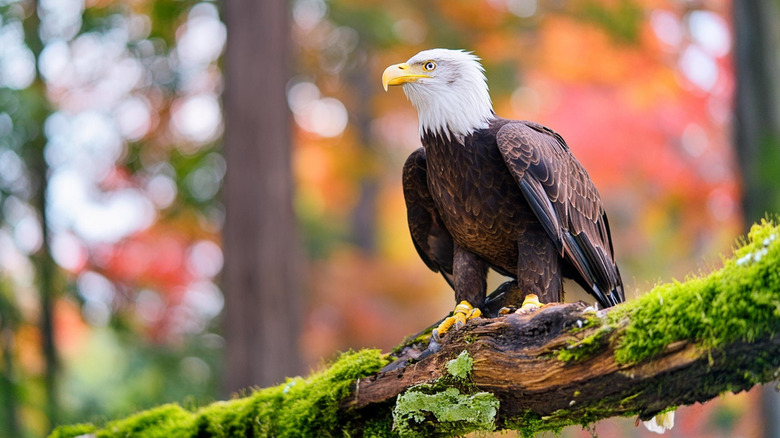Why Alaska Is One Of The Best Places To See Bald Eagles In The United States (And Where You Should Visit)
Featured on the Great Seal of the United States since 1782, the bald eagle has become a majestic symbol for the country, but it didn't officially become the national bird until December 2024. The bird hasn't had it easy surviving, though, and was once an endangered species. While it can be found across all of the contiguous United States now, the world's largest bald eagle population resides in Alaska and Canada. In fact, more of these birds live in Alaska than in the 48 contiguous states combined.
As animals that prefer a temperate climate, bald eagles can withstand cold temperatures because their thousands of feathers (including contour feathers) and fluffy, soft down protect them from low temperatures, high winds, ice, and snow. Alaska is located in both the North Temperate Zone and Arctic Circle, but the weather isn't the only reason why 40,000 to 50,000 of these birds call the state home. "The Last Frontier" has plenty of suitable, natural habitats and food for them, too, with fewer people to interfere.
Generally, bald eagles live around bodies of water — estuaries, lakes, marshes, and rivers — but they can be found in drier habitats, such as farmland and suburban and urban areas. In any case, their habitat needs to be suitable for nesting and have perching areas and plenty of accessible food. Speaking of which, bald eagles eat mostly fish but will also eat small animals, rabbits, snakes, turtles, and waterfowl. They may even scavenge dead fish and animals, as well as steal prey.
Where you should look for bald eagles in Alaska
Obviously, the best place to look for bald eagles in Alaska is around their natural habitats. The state has 16 national wildlife refuges where these majestic birds are rather commonplace. Turnagain Arm, Kenai River, and Prince William Sound are all popular grounds for eagles, but the Alaska Chilkat Bald Eagle Preserve is a standout spot.
As the Valley of the Eagles, this sanctuary was created in 1982 specifically to protect this critical habitat for such a high concentration of bald eagles. It consists of 48,000 acres of river-bottom land of three rivers and is home to 300 to 400 eagles year around. To view the eagles here, walk the 2-mile riverside trail or watch from the designated parking areas between the river and Haines Highway. You're more likely to see them when 3,000 to 4,000 of these birds congregate in late fall and early winter as they dine on the thousands of dying and finning fish amid the shallow river channels.
If you're visiting Alaska to see bald eagles outside of the congregation window and don't want to chance not seeing some, there are several facilities where bald eagle viewing is guaranteed. The Alaska Zoo in Anchorage, for instance, has a habitat for these birds. Another option, the Bird Treatment and Learning Center (also in Anchorage), rescues and rehabilitates birds to be released into the wild. The birds that can't be returned may become ambassadors for in-person education and programs – those ambassadors include bald eagles, falcons, snowy owls, and more. Under human care like this, American bald eagles can live around 50 years — much more than 20 to 30 years in the wild.
How to identify a bald eagle
Along with knowing where to look for bald eagles and what wild birds eat in Alaska, spotting one requires knowing what they look like and how they behave. The distinct differences between a bald eagle and a gold eagle, for instance, is one place to start. Both are large birds, with male bald eagles weighing up to 10 pounds with up to a 6-foot wingspan and females weighing up to 14 pounds with up to an 8-foot wingspan. Juveniles have brown and white colored mottled feathers and dark eyes and bills. They get their distinguished white heads and tails with brown bodies, bright yellow bills, and light eyes when they reach adulthood (about 5 years old). Gold eagles don't have these distinctions.
Since bald eagles are visual predators, they hunt for prey from perches and while flying overhead. You might see them diving toward the ground or water to catch their prey. If they get too wet while taking their prey out of the water and can't fly well right away, they will use their wings to row atop the water surface. Outside of breeding season, bald eagles like to gather in communal roosts where you can hear a lot of vocalization that's described as low in volume and similar to a snicker. These birds have even been seen passing sticks to each other mid-air as if they're playing.


